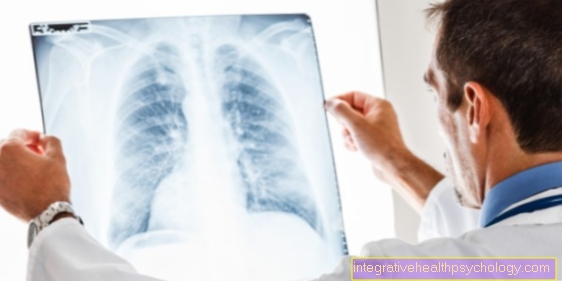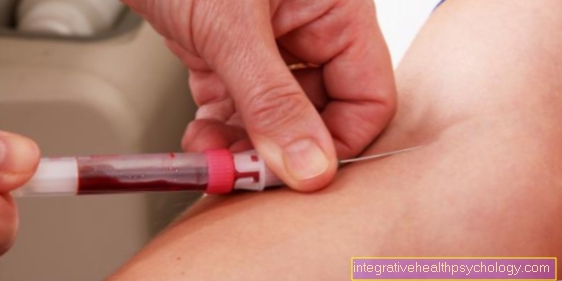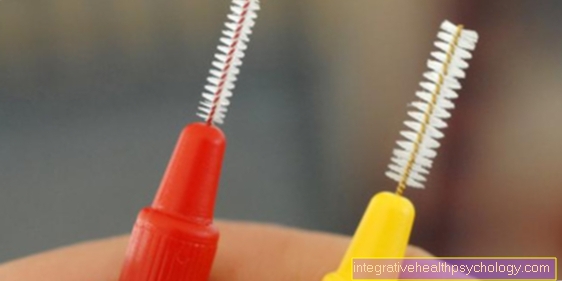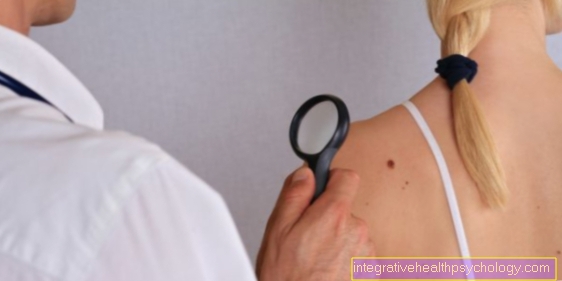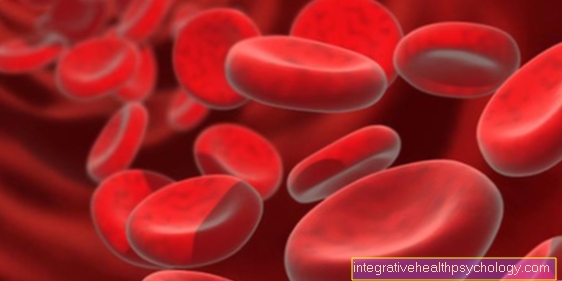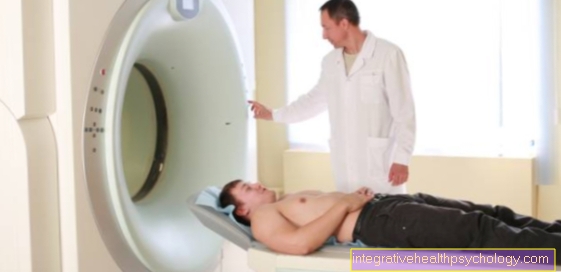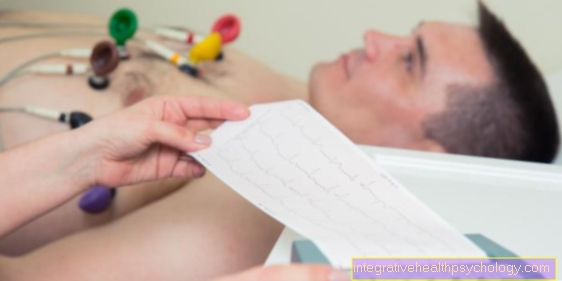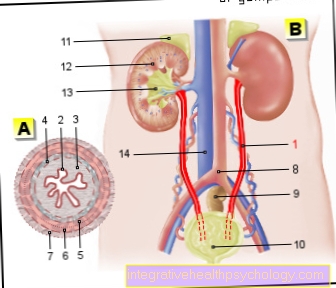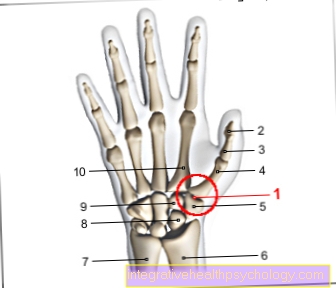ThermaCare® heating patches
introduction
ThermaCare® warming patches are over-the-counter medicines that can be used for the external treatment of pain, for example in the back. On the one hand there are heat packs and on the other hand heat pads that are usually stuck directly onto the skin and can be worn under clothing. Through a chemical reaction of the various ingredients with the oxygen in the air, a continuous heat release is generated. This should release muscular tension and relieve pain in this way.

When should you use ThermaCare® heating patches?
The main indications for ThermaCare® heat pads are muscle and joint pain, for example as a result of muscle tension or joint wear (arthrosis). The product is suitable, among other things, for pain in the lower back (sciatica or "lumbago") as well as painful tension in the neck or shoulders If there are also abnormal sensations or even paralyzed muscles in the arms or legs, it is imperative that you see your doctor as soon as possible.
Even if it can cause great suffering, pain in the musculoskeletal system (muscles and joints) in most cases has a harmless cause. In rare cases, however, it can also be a serious injury such as a herniated disc.
Further indications for the application can be chronic joint inflammation, for example from the group of rheumatic diseases (such as the Rheumatoid arthritis). If necessary, the attending physician should be asked whether he considers the use of ThermaCare® warming plasters appropriate.
Read more on the topic: Symptoms of a herniated disc
How does the heating patch work?
ThermaCare® warming patches contain a mixture of different ingredients that react with the oxygen in the air. This chemical reaction releases heat. The ingredients are primarily iron powder as well as activated charcoal, salt and a little water.As soon as the ThermaCare heating patches are removed from the airtight packaging, the substances react with the oxygen in the air. It is a kind of controlled combustion or else oxidation called. The resulting heat of reaction is then continuously given off to the body. This should relax the muscles and thus alleviate pain.
The principle of these iron powder-based heat patches differs from many other products in which no heat is generated at all, but instead a reaction in the skin occurs due to special active ingredients that only gives the feeling of warmth. The effect of ThermaCare® and comparable products from other manufacturers, on the other hand, is not conveyed by directly influencing the skin with active ingredients, but purely physically via the actual heat generated (comparable to a hot water bottle or a grain pillow).
Read more on the topic: Tension
Side effects
Since the effect of the ThermaCare® warming plaster is only caused by the local generation of heat, side effects are not likely. There is no absorption of active substances through the skin. The most likely possible side effects are caused by excessive heat supply, for example with previously damaged or sensitive skin. This then manifests itself as a slight burn which can lead to reddening and pain in the skin.
If the patch is felt to be too hot, it must be removed immediately. It is therefore not advisable to use it in areas of the body with reduced heat perception. If these recommendations are adhered to, the occurrence of side effects when using ThermaCare® warming plasters is not to be expected. Tests carried out on heat plasters from other manufacturers revealed allergic skin reactions as side effects. Since ThermaCare® warming plasters do not contain any additives with an allergic potential, side effects are not to be expected.
You might also be interested in this article: Therapy for chronic back pain - what works best?
interaction
Interactions with other medicinal products are not to be expected when using ThermaCare® heat patches. There is no direct influence on the body through the active ingredients, but only an indirect effect through the released heat. However, it is not recommended to use ThermaCare® warming patches together with other types of heat supply (grain pillows, hot water bottles) and medicinal ointments. Otherwise, skin irritation or damage may occur.
When should ThermaCare® warming patches not be used?
ThermaCare® warming patches should not be used if the airtight packaging of the individual patches is damaged or leaking, or if the warming patch itself is obviously damaged. In addition, the product should not be used on diseased, injured or damaged skin. The use of ThermaCare® heat patches (as well as other forms of heat supply) also speaks against pain that has only recently occurred (e.g. within the past 48 hours), such as bruises. Instead of applying heat, such injuries should be cooled and, if necessary, stored up in order to promote swelling.
Other contraindications are pain in the head, in the groin, on the feet or toes and in the hollow of the knee. ThermaCare® heating plasters are also not suitable for this. In the case of certain diseases such as diabetes, circulatory disorders, heart diseases and rheumatic joint diseases, you should consult a doctor before using ThermaCare heat patches. The same applies to use during pregnancy.
Use on the neck
ThermaCare® offers special neck heat pads for use on the neck. Due to their fit, these are suitable for gluing around the neck and shoulders. These plasters can also provide relief from pain radiating into the arm. In terms of the principle of action, they do not differ from the usual ThermaCare® thermal plasters. However, they contain a larger amount of the iron powder necessary for heat generation. This enables the effect to last for about twelve hours (instead of the otherwise expected duration of eight hours).
The plasters for the neck have smaller adhesive surfaces so that the skin on the neck, which is usually somewhat sensitive, is less irritated. However, the normal ThermaCare heating patches can also be used on the neck. In any case, it is important that you shouldn't lie on the patch and that it is best to stick it in the morning after getting up. With high-necked clothing (for example shirt or blouse), the plaster can be worn under clothing without attracting attention in everyday life. The ThermaCare® heat pads for the neck can also be used for wrist complaints due to its fit.
You might also be interested in this article: Active treatment concept for chronic neck pain
Use on the back
Probably the most common area of application of ThermaCare® heat plasters is the back. The lower back in the lumbar spine (lumbar spine) area in particular causes pain for many people. Incorrect strain, lack of exercise and tension are the most common causes of this. Local application of heat can often help alleviate the symptoms. One of the many possible means for this is the ThermaCare® warming plasters. This is stuck directly to the area on the back from which the pain originates. The plaster should be attached as centrally as possible and not just on the left or right side.
It is best to apply the plaster in the morning or noon and remove it in the evening, as you shouldn't lie on it. Some people experience relief from the warmth, others notice no difference and some may even worsen. Therefore, the user should make sure whether he benefits from the ThermaCare® heat patches with regard to back pain. In the case of persistent and very severe pain that cannot be relieved, it can also be useful to see your doctor.
Read more on the topic: Back pain - optimally recognize and treat
Application on the shoulder
ThermaCare® heat patches can also be used to treat tension and pain in the shoulders. For example, the special neck heat pads that are simply glued to the affected shoulder are suitable for this. Just like when using it on the neck, the plaster should not be worn while lying down.
Read more about: Shoulder pain
dosage
A dosage of ThermaCare® warming patches is mainly based on the duration of use, i.e. how long the product is worn on the body. After the patches have been stuck on the affected area of the body, it takes about 30 minutes for them to warm up to 40 degrees Celsius and for the effects to develop. This effect then lasts for up to eight hours. In order to warm up deeper tissue and muscle layers, which should lead to the desired pain relief, an application of at least three hours is recommended. However, if the patch is found to be too hot or otherwise uncomfortable, it should be removed early. In addition, it should be removed at the latest when no more heat is released.
price
The price for ThermaCare® warming plasters varies a lot and depends on the one hand on the size of the pack and on the other hand on the type of plaster (for example for the neck or back). In addition, the prices in the local pharmacy or drugstore can differ from those of the Internet providers. For example, four ThermaCare® back envelopes cost around 20 euros. The price for a pack with two Thermacare® heat pads for larger painful areas is around eleven euros. Two heat pads for the neck are available for around eight euros. It is well worth comparing the prices, as the product is sometimes available at reduced prices both in pharmacies and on the Internet. If you can't or don't want to spend so much money on the heating patches, you can try a treatment with “classic” heaters such as hot water bottles, grain pillows or a red light lamp.
Use during breastfeeding
In principle, ThermaCare® heat plasters can be used when breastfeeding. No active ingredients are transferred from the product into the mother's body, so that there is no danger to the baby when breastfeeding. You should only make sure that the child is not exposed to the heat released by the patch and it must never be used directly on the child.
You might also be interested in this article: Painkillers while breastfeeding
ThermaCare® ointment
In addition to the ThermaCare® heat plasters, the manufacturer of this product also offers an ointment for the treatment of muscle tension and joint pain. This so-called ThermaCare® pain gel contains the active ingredient Felbinac and, in contrast to ThermaCare heat plasters, can only be purchased in pharmacies (pharmacy only). You don't need a prescription either. It is a transparent gel that can be applied directly to the affected area in the event of strains or bruises.
The ointment develops its effect mainly through the active ingredient Felbinac from the group of so-called NSAIDs (non-steroidal anti-inflammatory drugs). These have an analgesic and anti-inflammatory effect. In contrast to ThermaCare® heat patches, the body is directly influenced by an active ingredient. In addition, the ointment has a cooling effect, which is desirable for new injuries. We therefore advise against combining the ointment with ThermaCare heat patches. In addition, the ointment should be avoided in certain illnesses or only used after consultation with a doctor. These include in particular diseases of the kidneys, which are associated with impaired kidney function.
Read more on the topic: ThermaCare®

.jpg)



